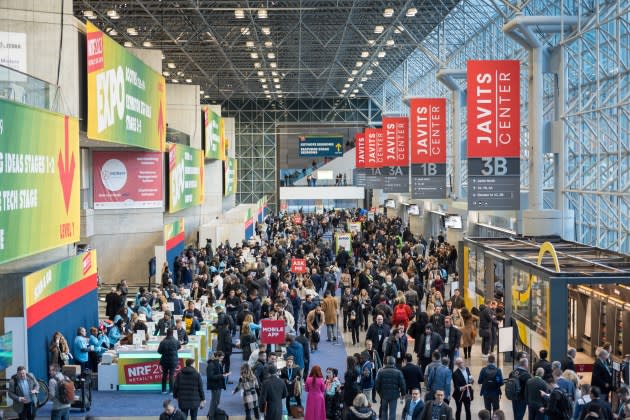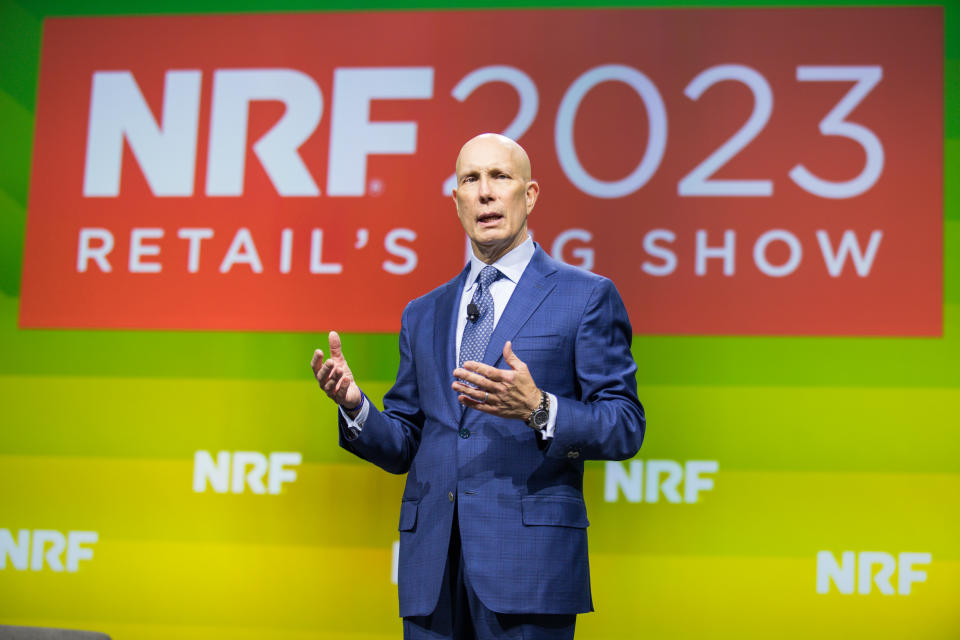At NRF’s Big Show, Crowds, Concerns and Colloquies for Solutions

Coming off a decent holiday season while entering 2024 with as many uncertainties and concerns as last year, retailers and those that supply and support them will converge on New York’s Javits Center this weekend through Tuesday for the annual NRF “Big Show” convention and trade fair.
It’s truly a big show, with an expected record crowd of more than 40,000 attendees from 100 countries — a few thousand more than pre-pandemic levels, according to organizers. About 1,000 exhibitors will be occupying 300,000 square feet of expo space on levels one, three and four of the Javits, and 450 speakers and 190 sessions are scheduled across 11 stages.
More from WWD
Urban Outfitters Bullish While NRF Economist Signals Caution
Target Closing Nine Stores Due to Organized Theft, Safety Concerns
“It’s been a very, very healthy environment for continued growth of the show,” Matt Shay, president and chief executive officer of the NRF, told WWD. “There’s this energy in the retail and consumer economy that has remained so robust since the pandemic, powering GDP growth for 43 months in a row now. That just speaks to the resilience of the consumer and to the innovative approaches that the retailers are taking to continue to engage with customers in new ways.”
The NRF forecast last year that U.S. retail for the holiday season will be up 3 to 4 percent, and on Wednesday, the CNBC/NRF Retail Monitor tracking monthly sales reported that core retail sales, which excludes restaurant, gas and auto sales, for November and December, were up 3.3 percent. Inflation, currently at 3.2 percent in the U.S., is not factored into NRF’s figures, so it could be argued that retailing is essentially flat, though Shay’s perspective is different.
“One of the challenges we have been facing is that inflation in some categories, particularly on the services side and with rent have been running pretty high, and some categories have still seen price increases, but most retail categories have actually been deflationary and are running well below the headline inflation numbers,” said Shay. “So there’s real growth in that three-and-a-half percent and it’s in the range of the 10-year average. There’s growth on a real basis because costs are not growing on many retail goods.”
Shay said retailers are concerned about how the economy will hold up at the macro level in 2024, what the Federal Reserve will do in its battle against inflation. and what kind of impact might that have on the primary driver of consumer behavior, which is employment and wages. “Up till now, we’ve had historically low unemployment numbers,” said Shay. “We’ve had very solid wage growth in excess of inflation over the course of the last year. And that combination of low unemployment and higher sustained wage growth and excessive inflation, combined still with some excess savings, has given consumers the resources they need to continue engaging in commerce — and that’s been driving retail sales. The open question for 2024 is how well will those factors hold up in the face of Federal Reserve decisions,” Shay said.
The presidential election and the campaigning leading up could impact consumer spending. Asked about that, Shay replied, “The way consumers think about their job security, career prospects, their livelihood, the strength and health of the economy, those are the things that shape consumer behavior. There are external dynamics that cause consumers to adjust their behavior, based on things outside of their control. But what’s most fascinating is there’s historically a real distinction between consumer confidence and consumer conduct. Confidence levels could be low but their behavior still shows them engaged in commerce. It really is about employment, job security and wages. Consumers have the ability to hold two thoughts in their mind simultaneous. They can recognize what’s going on around them, and yet they can still be engaged in supporting the economy through commerce. There’s a difference between attitudes and actions.”

At the NRF convention, attendees will be drawn to the Innovation Lab spotlighting new products and technologies; the “Big Idea” sessions with case studies; the “Startup Hub” showcasing new companies, various store tours, and the expanded Food Service Innovation Zone with chefs, demos, food tech booths, even a bot for streamlining pizza making.
New to the event this year: the NRF Supply Chain 360 Summit, a day-long program with experts explaining how to build a strong supply chain, and a Sustainable Retail Workshop for a half day of learning about creating a circular retail industry.
Among those on the speakers’ bill: Earvin “Magic” Johnson, Walmart’s John Furner, Hal Lawton from Tractor Supply, Marc Metrick from Saks, Barnes & Noble’s James Daunt, Stephanie Linnartz from Under Armour, Martha Stewart, Philippe Schaus of Moët Hennessy, Gina Drosos from Signet Jewelers, Ariana Huffington, Marc Benicoff of Salesforce, Dave Kimbell of Ulta Beauty, Raj Subramaniam of FedEx, and Harley Finkelstein of Shopify.
Aside from the economy and world affairs, retail crime is a top concern and high on NRF’s lobbying agenda in Washington. “We’re going to push for a solution,” Shay said. “We’ve got 100 cosponsors of legislation that is currently pending in Congress. This particular piece of legislation would create in the Department of Homeland Security a specific set of responsibilities for coordinating across federal, state and local law enforcement to ensure that we had the appropriate information and resource sharing to really combat the problem. We’re not talking about shoplifters stealing single items for personal use. These are sophisticated, well resourced and highly creative professionals operating across states, regions and countries, using all the tools at their disposal including technology and other means to engage in crime and theft, and that requires a more sophisticated response, which we are proposing. This is very bipartisan. We’ve got Republicans and Democrats who want to find a solution. The challenge is simply finding time on the legislative calendar because it is an election year.
“The next thing on everybody’s list is ensuring we have a strong and healthy economy and that we don’t enact policy and regulatory solutions that make the economy more challenging rather than less challenging. We’ve still got consumers engaged in commerce. We’ve got low unemployment. We’ve got growing wages. The economy is actually at a good place. We need to keep that going.”
Other major topics that will be addressed at the conference are AI, labor, ports and shipping disruptions due to warfare, responding to shifting consumer shopping patterns and unified commerce. NRF’s Big Show, which this year is themed “Make It Happen,” is where retailers, large and small, seek solutions and discover best business practices and new technologies. It’s also a huge venue for networking and reuniting with friends and colleagues.
“There are certainly things that are outside retailers’ control,” said Shay. “What we expect retailers to be talking about at the show next week are solutions, technologies, partnerships that can help them continue to reach and serve their customers, and deliver value for them and stay engaged with them.”
Best of WWD

